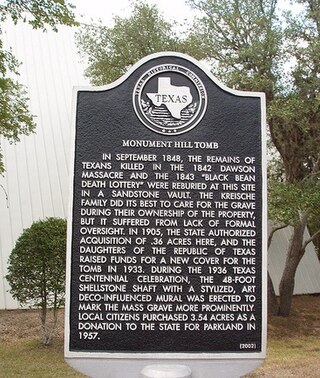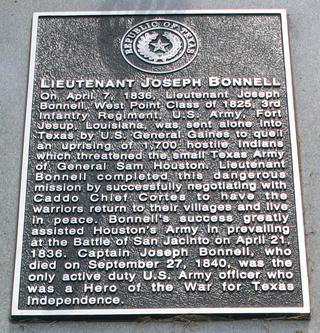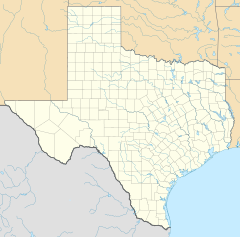
Cherokee County is a county located in the U.S. state of Texas. As of the 2020 census, its population was 50,412. The county seat is Rusk, which lies 130 miles southeast of Dallas and 160 miles north of Houston. The county was named for the Cherokee, who lived in the area before being expelled in 1839. Cherokee County comprises the Jacksonville micropolitan statistical area, which is also included in the Tyler–Jacksonville combined statistical area.
James Kerr was a doctor, politician, Senator in Missouri, soldier, surveyor and Congressman in Texas who was active in the establishment of the Republic of Texas.
This is a timeline of the Republic of Texas, spanning the time from the Texas Declaration of Independence from Mexico on March 2, 1836, up to the transfer of power to the State of Texas on February 19, 1846.

The Dawson massacre, also called the Dawson expedition, was an incident in which 36 Texian militiamen were killed by Mexican soldiers on September 17, 1842 near San Antonio de Bexar. The event occurred during the Battle of Salado Creek, which ended with a Texian victory. This was among numerous armed conflicts over the area between the Rio Grande and Nueces rivers, which the Republic of Texas tried to control after achieving independence in 1836.
The Texas–Indian wars were a series of conflicts between settlers in Texas and the Southern Plains Indians during the 19th-century. Conflict between the Plains Indians and the Spanish began before other European and Anglo-American settlers were encouraged—first by Spain and then by the newly Independent Mexican government—to colonize Texas in order to provide a protective-settlement buffer in Texas between the Plains Indians and the rest of Mexico. As a consequence, conflict between Anglo-American settlers and Plains Indians occurred during the Texas colonial period as part of Mexico. The conflicts continued after Texas secured its independence from Mexico in 1836 and did not end until 30 years after Texas became a state of the United States, when in 1875 the last free band of Plains Indians, the Comanches led by Quahadi warrior Quanah Parker, surrendered and moved to the Fort Sill reservation in Oklahoma.
The Battle of the Neches, the main engagement of the Cherokee War of 1838–1839, took place on 15–16 July in 1839 in what is now the Redland community. It resulted from the Córdova Rebellion and Texas President Mirabeau Bonaparte Lamar's determination to remove the Cherokee people from Texas. Many Cherokee had migrated there from the American Southeast to avoid being forced to Indian Territory.
William Clyde Thompson was a Texas Choctaw-Chickasaw leader of the Mount Tabor Indian Community in Texas and an officer of the Confederate States of America during the Civil War. After moving north to the Chickasaw Nation in 1889, he led an effort to gain enrollment of his family and other Texas Choctaws as Citizens by blood of the Choctaw Nation in Indian Territory. This was at the time of enrollment for the Final Roll of the Five Civilized Tribes, also known as the Dawes Rolls, which established citizenship in order for the nations to be broken up for white settlement and to allot communal tribal lands to individual Indians. The Choctaw Advisory Board opposed inclusion of the Texas Choctaw as well as the Jena Choctaws in Louisiana, as they had both lived primarily outside of the Choctaw Nation. Thompson's case eventually went to the United States Supreme Court to be decided where he and about 70 other Texas Choctaws who had relocated to Indian Territory ultimately had their status restored as Citizens by Blood in the Choctaw Nation.
The Yowani were a historical group of Choctaw people who lived in Texas. Yowani was also the name of a preremoval Choctaw village.

Joseph Bonnell was a formally recognized hero of the Texas Revolution. He was a West Point graduate and a member of The Long Gray Line.
The Treaty of Bird's Fort, or Bird's Fort Treaty was a peace treaty between the Republic of Texas and some of the Indian tribes of Texas and Oklahoma, signed on September 29, 1843. The treaty was intended to end years of hostilities and warfare between the Native Americans and the white settlers in Texas. The full title of the treaty was "Republic of Texas Treaty with the Indigenous Nations of the Delaware, Chickasaw, Waco, Tawakani, Keechi, Caddo, Anadahkah, Ionie, Biloxi, and Cherokee." The principal negotiators for the Republic of Texas were Edward H. Tarrant and George W. Terrell.
The Bowl ; John Watts Bowles was one of the leaders of the Chickamauga Cherokee during the Cherokee–American wars, served as a Principal Chief of the Cherokee Nation–West, and was a leader of the Texas Cherokees.
The Cherokee have participated in over forty treaties in the past three hundred years.
Texas Cherokees were the small settlements of Cherokee people who lived temporarily in what is now Texas, after being forcibly relocated from their homelands, primarily during the time that Spain, and then Mexico, controlled the territory. After the Cherokee War of 1839, the Cherokee communities in Texas were once again forcibly removed to Indian Territory in present-day Oklahoma. When Union troops took control of Cherokee territory in 1863, many "Southern" Cherokees fled to Texas, but after the war, most of them returned to their homes in Indian Territory. Others are part of the multitribal Mount Tabor Indian Community, or Tsalagiyi Nvdagi Tribe which have received commendations for their contributions to the State of Texas.
The Córdova Rebellion, in 1838, was an uprising instigated in and around Nacogdoches, Texas. Alcalde Vicente Córdova and other leaders supported the Texas Revolution as long as it espoused a return to the Constitution of 1824.

The Republic of Texas was a North American nation from 1836 to 1846; in its short time it established diplomatic relations worldwide, mainly through the cotton trade.
The Battle of Village Creek occurred on May 24, 1841, on the embankments of Village Creek. The battle, which evolved into a running gunfight between the Republic of Texas militia and the Village Creek tribes, was attributed to the increased Native American raids on Anglo settlements in the Red River counties.
Larissa is a rural community and abandoned townsite in northwestern Cherokee County, Texas, United States. Larissa lies west of U.S. Highway 69, off Farm to Market Road 855 and approximately halfway between Jacksonville and Bullard. Larissa is about 20 miles (32 km) northwest of the county seat of Rusk.

The Texas Army, officially the Army of the Republic of Texas, was the land warfare branch of the Texas Military Forces during the Republic of Texas. It descended from the Texian Army, which was established in October 1835 to fight for independence from Centralist Republic of Mexico in the Texas Revolution. The Texas Army was provisionally formed by the Consultation in November 1835; however, it did not replace the Texian Army until after the Battle of San Jacinto. The Texas Army, Texas Navy, and Texas Militia were officially established on September 5, 1836, in Article II of the Constitution of the Republic of Texas. The Texas Army and Texas Navy were merged with the United States Armed Forces on February 19, 1846, after the Republic of Texas became the 28th state of America.

Sam Houston had a diverse relationship with Native Americans, particularly the Cherokee from Tennessee. He was an adopted son, and he was a negotiator, strategist, and creator of fair public policy for Native Americans as a legislator, governor and president of the Republic of Texas. He left his widowed mother's home around 1808 and was taken in by John Jolly, a leader of the Cherokee. Houston lived in Jolly's village for three years. He adopted Cherokee customs and traditions, which stressed the importance of being honest and fair, and he learned to speak the Cherokee language. He felt that Cherokees and other indigenous people had been short-changed during negotiation of treaties with United States government, the realization influenced his decisions as a military officer, treaty negotiator, and in his roles as governor of the states of Tennessee and Texas, and president of the Republic of Texas.







